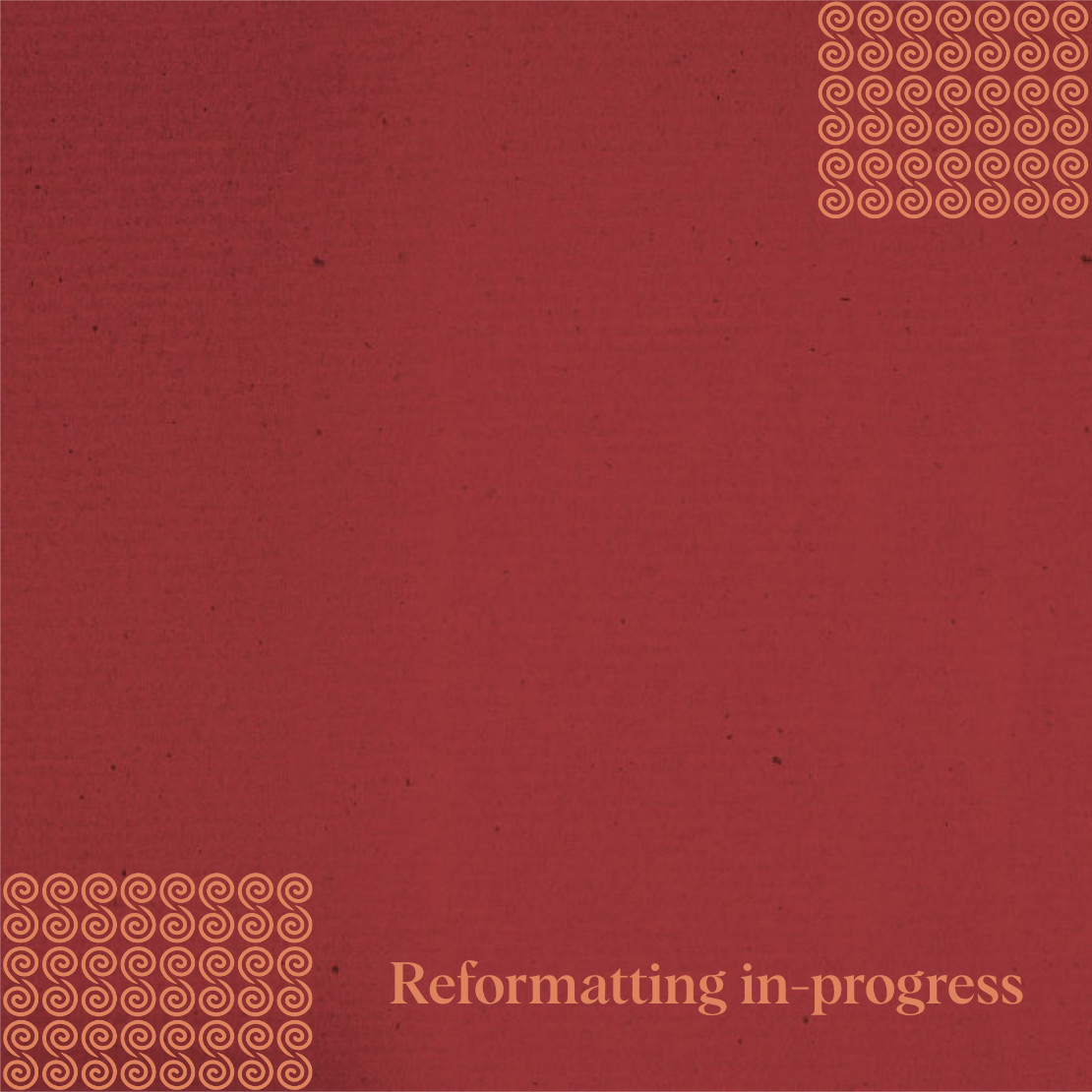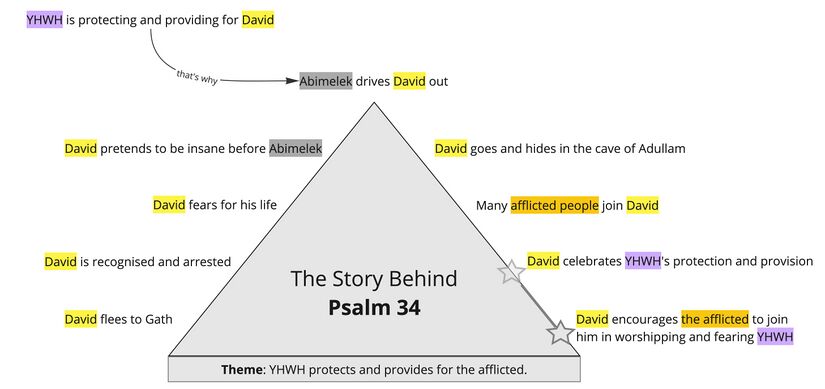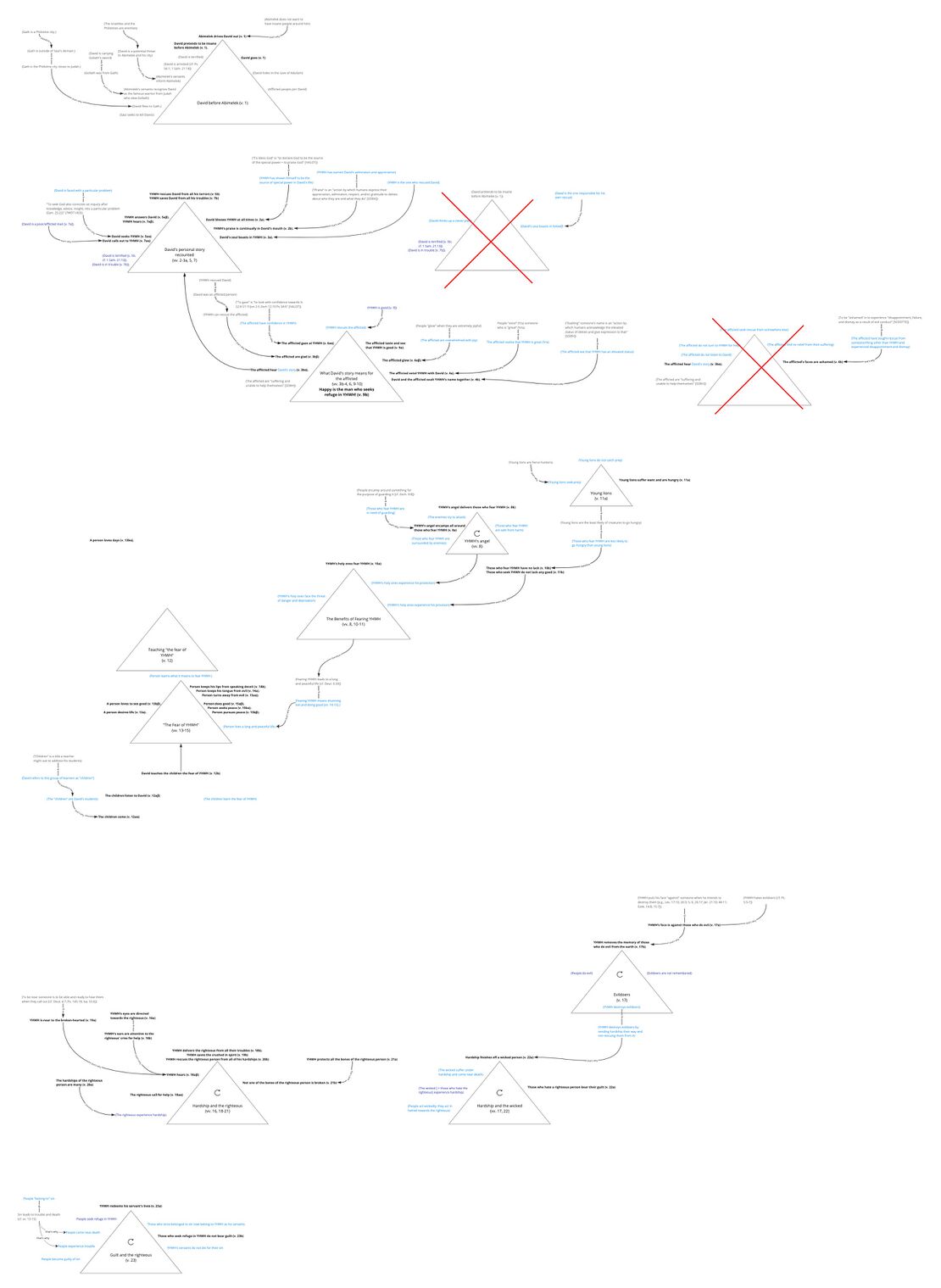Psalm 34 Story Behind
About the Story Behind Layer
The Story Behind the Psalm shows how each part of the psalm fits together into a single coherent whole. Whereas most semantic analysis focuses on discrete parts of a text such as the meaning of a word or phrase, Story Behind the Psalm considers the meaning of larger units of discourse, including the entire psalm.
The goal of this layer is to reconstruct and visualize a mental representation of the text as the earliest hearers/readers might have conceptualized it. We start by identifying the propositional content of each clause in the psalm, and then we identify relevant assumptions implied by each of the propositions. During this process, we also identify and analyze metaphorical language (“imagery”). Finally, we try to see how all of the propositions and assumptions fit together to form a coherent mental representation. The main tool we use for structuring the propositions and assumptions is a story triangle, which visualizes the rise and fall of tension within a semantic unit. Although story triangles are traditionally used to analyze stories in the literary sense of the word, we use them at this layer to analyze “stories” in the cognitive sense of the word—i.e., a story as a sequence of propositions and assumptions that has tension.
Summary Triangle
The story triangle below summarises the story of the whole psalm. We use the same colour scheme as in Participant Analysis. The star icon along the edge of the story-triangle indicates the point of the story in which the psalm itself (as a speech event) takes place. We also include a theme at the bottom of the story. The theme is the main message conveyed by the story-behind.
| Story Triangles legend | |
|---|---|
| Propositional content (verse number) | Propositional content, the base meaning of the clause, is indicated by bold black text. The verse number immediately follows the correlating proposition in black text inside parentheses. |
| Common-ground assumption | Common-ground assumptions[1] are indicated by gray text. |
| Local-ground assumption | Local-ground assumptions[2] are indicated by dark blue text. |
| Playground assumption | Playground assumptions[3] are indicated by light blue text. |
| The point of the story at which the psalm takes place (as a speech event) is indicated by a gray star. | |
| If applicable, the point of the story at which the psalm BEGINS to take place (as a speech event) is indicated with a light gray star. A gray arrow will travel from this star to the point at which the psalm ends, indicated by the darker gray star. | |
| A story that repeats is indicated by a circular arrow. This indicates a sequence of either habitual or iterative events. | |
| A story or event that does not happen or the psalmist does not wish to happen is indicated with a red X over the story triangle. | |
| Connections between propositions and/or assumptions are indicated by black arrows with small text indicating how the ideas are connected. | |
| Note: In the Summary triangle, highlight color scheme follows the colors of participant analysis. | |
Background ideas
Following are the common-ground assumptionsCommon-ground assumptions include information shared by the speaker and hearers. In our analysis, we mainly use this category for Biblical/Ancient Near Eastern background. which are the most helpful for making sense of the psalm.
- The appropriate response to YHWH's deliverance is to bless/praise YHWH (cf. Ps. 103).
- Lengthening one's days (i.e., living a long time) and seeing "good" is a tremendous blessing (cf. Ex. 20:12; Deut. 5:16, 33; 6:2; 25:15; 1 Kgs. 3:14; cf. Paul Sanders, "A Long Life as a Blessing in the Old Testament and the Ancient Levant," forthcoming).
- Fearing YHWH is the key to a long and peaceful life (cf. Deut. 5:33).
- The alphabet is a symbol of completeness (cf. Gottwald 1954:23-32; IVP Dictionary, “Acrostic”, Soll Anchor Bible Dictionary; Watson, Classical Hebrew Poetry 2001; Zenger 1993:211). In an acrostic poem, the poet takes a topic (e.g., Torah [Ps. 119], or the virtuous woman [Prov. 31]) and expounds on it completely (from every possible angle), so that the reader walks away with a high-resolution image of the topic (i.e., he/she understands it “from A to Z”).
Background situation
The background situation is the series of events leading up to the time in which the psalm is spoken. These are taken from the story triangle – whatever lies to the left of the star icon.

Expanded Paraphrase
The expanded paraphrase seeks to capture the implicit information within the text and make it explicit for readers today. It is based on the CBC translation and uses italic text to provide the most salient background information, presuppositions, entailments, and inferences.
| Expanded paraphrase legend | |
|---|---|
| Close but Clear (CBC) translation | The CBC, our close but clear translation of the Hebrew, is represented in bold text. |
| Assumptions | Assumptions which provide background information, presuppositions, entailments, and inferences are represented in italics. |
| Text (Hebrew) | Verse | Expanded Paraphrase |
|---|---|---|
| לְדָוִ֗ד בְּשַׁנּוֹת֣וֹ אֶת־טַ֭עְמוֹ לִפְנֵ֣י אֲבִימֶ֑לֶךְ וַֽ֝יְגָרֲשֵׁ֗הוּ וַיֵּלַֽךְ׃ | 1 | This song was written By David. He wrote it as he reflected on the time when he fled to the Philistine city of Gath and was recognized as the famous warrior of Judah who had slain Goliath of Gath and was arrested by the servants of Abimelek the king of Gath. David was afraid for his life, and in an attempt to escape, he pretended to be insane before Abimelek, and Abimelek falling for the trick and not wishing to have insane people around him drove him (David) out of his presence, and he (David) went safely away from Gath and hid in the cave of Adullam where many afflicted people joined him. David said to them |
| אֲבָרֲכָ֣ה אֶת־יְהוָ֣ה בְּכָל־עֵ֑ת תָּ֝מִ֗יד תְּֽהִלָּת֥וֹ בְּפִֽי׃ | 2 | YHWH has rescued me! So, in response to what YHWH has done for me I will bless YHWH at all times. YHWH has earned my constant admiration and appreciation, and so His praise will continually be spoken and sung in my mouth. |
| בַּ֭יהוָה תִּתְהַלֵּ֣ל נַפְשִׁ֑י יִשְׁמְע֖וּ עֲנָוִ֣ים וְיִשְׂמָֽחוּ׃ | 3 | My soul boasts not in myself, but in YHWH because I did not save myself. Rather, YHWH is the one who rescued me. May the afflicted hear about what YHWH did for me and be glad because, if YHWH can rescue me, an afflicted person, then he can rescue other afflicted people, too! |
| גַּדְּל֣וּ לַיהוָ֣ה אִתִּ֑י וּנְרוֹמְמָ֖ה שְׁמוֹ יַחְדָּֽו׃ | 4 | Extol YHWH with me, all you afflicted people, because YHWH is great, and let us exalt his name together! |
| דָּרַ֣שְׁתִּי אֶת־יְהוָ֣ה וְעָנָ֑נִי וּמִכָּל־מְ֝גוּרוֹתַ֗י הִצִּילָֽנִי׃ | 5 | I myself was afflicted. I was afraid for my life, and I did not know what to do. But then I sought YHWH to see what I should do and he answered me and gave me the idea and the ability to pretend to be insane before Abimelek and he made the attempt successful, so that Abimelek drove me out and thus he (YHWH) rescued me from all my terrors. |
| *הַבִּיטוּ* אֵלָ֣יו *וּנְהָרוּ* וּפְנֵיכֶם* אַל־יֶחְפָּֽרוּ׃* | 6 | When you are in a similar situation, afflicted like I was, gaze at him (YHWH) with confident expectation and you will glow with joy, because he will answer your prayer and you will not be disappointed, and do not seek help from elsewhere and so let your faces be ashamed! |
| זֶ֤ה עָנִ֣י קָ֭רָא וַיהוָ֣ה שָׁמֵ֑עַ וּמִכָּל־צָ֝רוֹתָ֗יו הוֹשִׁיעֽוֹ׃ | 7 | This —I am referring to myself— is a poor and afflicted man who called out to YHWH for help and YHWH heard him and saved him from all his troubles. If YHWH saved me, then he can save you too, if you call out to him amidst your troubles. |
| חֹנֶ֤ה מַלְאַךְ־יְהוָ֓ה סָ֘בִ֤יב לִֽירֵאָ֗יו וַֽיְחַלְּצֵֽם׃ | 8 | Whenever YHWH's people are surrounded by enemies YHWH's angel encamps all around those who fear him to guard them on every side and when the enemies try to attack he delivers them (those who fear YHWH) so that they are safe from all harm. |
| טַעֲמ֣וּ וּ֭רְאוּ כִּי־ט֣וֹב יְהוָ֑ה אַֽשְׁרֵ֥י הַ֝גֶּ֗בֶר יֶחֱסֶה־בּֽוֹ׃ | 9 | YHWH delivers his people, because YHWH is good. Call out to him for deliverance, and so Taste and see for yourself that YHWH is good! Happy is the man who seeks refuge in him. |
| יְר֣אוּ אֶת־יְהוָ֣ה קְדֹשָׁ֑יו כִּי־אֵ֥ין מַ֝חְס֗וֹר לִירֵאָֽיו׃ | 10 | Fear YHWH, you holy ones of his who belong to him and are devoted to his service! For those who fear him have no lack. Therefore, if you fear YHWH, he will provide for you, and you will not lack. |
| כְּ֭פִירִים רָשׁ֣וּ וְרָעֵ֑בוּ וְדֹרְשֵׁ֥י יְ֝הוָ֗ה לֹא־יַחְסְר֥וּ כָל־טֽוֹב׃ | 11 | Even Young lions who, being fierce hunters are the least likely of all creatures to go hungry have suffered want and been hungry, but those who seek YHWH and do not, like lions, rely on their own power to meet their needs will not lack any good. |
| לְֽכוּ־בָ֭נִים שִׁמְעוּ־לִ֑י יִֽרְאַ֥ת יְ֝הוָ֗ה אֲלַמֶּדְכֶֽם׃ | 12 | Come, you who are my students and so are like my children! Listen to me! I will teach you the fear of YHWH. |
| מִֽי־הָ֭אִישׁ הֶחָפֵ֣ץ חַיִּ֑ים אֹהֵ֥ב יָ֝מִ֗ים לִרְא֥וֹת טֽוֹב׃ | 13 | Who among you is the person who desires life, who wants to live a long time, who loves to see good? Surely, each of you desires a long life full of good for this is widely regarded as a tremendous blessing. |
| נְצֹ֣ר לְשׁוֹנְךָ֣ מֵרָ֑ע וּ֝שְׂפָתֶ֗יךָ מִדַּבֵּ֥ר מִרְמָֽה׃ | 14 | If you are such a person, then here's what you must do: Keep your tongue from speaking evil and your lips from speaking deceit! |
| ס֣וּר מֵ֭רָע וַעֲשֵׂה־ט֑וֹב בַּקֵּ֖שׁ שָׁל֣וֹם וְרָדְפֵֽהוּ׃ | 15 | Turn away from evil and do good! Seek peace and pursue it! This is what it means, practically, to fear YHWH, and those who fear YHWH will live long and happy lives, because YHWH protects and provides for those who fear him. |
| פְּנֵ֣י יְ֭הוָה בְּעֹ֣שֵׂי רָ֑ע לְהַכְרִ֖ית מֵאֶ֣רֶץ זִכְרָֽם׃ | 17 | By contrast, YHWH's face is against those who do evil, so as to remove the memory of them from the earth so that those who do evil will never be remembered. |
| עֵינֵ֣י יְ֭הוָה אֶל־צַדִּיקִ֑ים וְ֝אָזְנָ֗יו אֶל־שַׁוְעָתָֽם׃ | 16 | YHWH's eyes are directed towards the righteous so that he sees them in their distress, and his ears are attentive to their cries for help so that he hears them when they cry out to him. |
| צָעֲק֣וּ וַיהוָ֣ה שָׁמֵ֑עַ וּמִכָּל־צָ֝רוֹתָ֗ם הִצִּילָֽם׃ | 18 | Here is something that I have seen in the past, and it is typical of what happens again and again: When the righteous experienced trouble they called for help, and YHWH heard them, and he delivered them from all their troubles. |
| קָר֣וֹב יְ֭הוָה לְנִשְׁבְּרֵי־לֵ֑ב וְֽאֶת־דַּכְּאֵי־ר֥וּחַ יוֹשִֽׁיעַ׃ | 19 | YHWH delivers the righteous, who are afflicted, because YHWH is near to the broken-hearted and thus he is able to hear them when they call out for help and he saves the crushed in spirit. |
| רַ֭בּוֹת רָע֣וֹת צַדִּ֑יק וּ֝מִכֻּלָּ֗ם יַצִּילֶ֥נּוּ יְהוָֽה׃ | 20 | The hardships of the righteous are many, but YHWH rescues him from all of them. |
| שֹׁמֵ֥ר כָּל־עַצְמוֹתָ֑יו אַחַ֥ת מֵ֝הֵ֗נָּה לֹ֣א נִשְׁבָּֽרָה׃ | 21 | He (YHWH) protects all his (the righteous person's) bones. Not one of them has broken. |
| תְּמוֹתֵ֣ת רָשָׁ֣ע רָעָ֑ה וְשֹׂנְאֵ֖י צַדִּ֣יק יֶאְשָֽׁמוּ׃ | 22 | By contrast, YHWH does not rescue the wicked from hardship. Instead, hardship afflicts and then eventually finishes off a wicked person, and in this way those who hate a righteous person bear their guilt. |
| פּוֹדֶ֣ה יְ֭הוָה נֶ֣פֶשׁ עֲבָדָ֑יו וְלֹ֥א יֶ֝אְשְׁמ֗וּ כָּֽל־הַחֹסִ֥ים בּֽוֹ׃ | 23 | Whereas the wicked become guilty of sin, experience hardship as a result of their sin, and then eventually die from their hardships, YHWH forgives, and thereby redeems his servants' lives from sin, hardship, and death so that they no longer belong to sin, hardship, and death but now belong to him as his servants and so no one who seeks refuge in him will ever bear guilt. |
There are currently no Imagery Tables available for this psalm.
Bibliography
- Allegro, John Marco. 1955.“Uses of the Semitic Demonstrative Element Z in Hebrew.” Vetus Testamentum, vol. 5, no. 3 July: pp. 309–12.
- Baethgen, Friedrich. 1904. Die Psalmen. Göttingen: Vandenhoeck und Ruprecht.
- Bratcher, Robert G., and William D. Reyburn. 1991. A Handbook on Psalms. UBS Handbook Series. New York: United Bible Societies.
- Ceresko, Anthony. 1985. “The ABCs of Wisdom in Psalm Xxxiv.” VT 35: 99–104.
- Craigie, Peter C. 2004. Psalms 1–50. WBC 19. Waco, TX: Word.
- Delitzsch, Franz. Biblical Commentary on the Psalms: Vol. 1. Translated by Eaton David. Vol. 1. New York: Funk and Wagnalls, 1883.
- Eriksson, Lars Olov. 1991. “Come, Children, Listen to Me!”: Psalm 34 in the Hebrew Bible and in Early Christian Writings. Coniectanea Biblica 32. Stockholm: Almquist & Wiksell.
- Fokkelman, J.P. 2003. Major Poems of the Hebrew Bible: At the Interface of Prosody and Structural Analysis (Vol 3: The Remaining 65 Psalms). Vol. 3. Studia Semitica Neerlandica. Van Gorcum.
- Freedman, David Noel. 1992. "Patterns in Psalms 25 and 34", in Priests, Prophets, and Scribes JSOT 149, Sheffield: Sheffield Academic Press.
- Gentry, Peter. 2013. "The Meaning of 'Holy' in the Old Testament." Bibliotheca Sacra 170, no. 677-680: 400-417.
- Goldingay, John. 2006. Psalms: Psalms 1–41. Vol. 1. BCOT. Grand Rapids: Baker Academic, 2006.
- Gunkel, Hermann. Die Psalmen. 4th ed. Göttinger Handkommentar Zum Alten Testament 2. Göttingen: Vandenhoeck & Ruprecht, 1926.
- Hossfeld, Frank-Lothar, and Erich Zenger. 1993. Die Psalmen I: Psalm 1–50. Neue Echter Bibel. Würzburg: Echter.
- Hupfeld, Hermann. 1868. Die Psalmen. Vol. 2. Gotha: Friedrich Andreas Perthes.
- Jenni, Ernst. 1992. Die Hebräischen Präpositionen Band 1: Die Präposition Beth. Stuttgart: W. Kohlhammer.
- ___. 2000. Die Hebräischen Präpositionen Band 3: Die Präposition Lamed. Stuttgart: Verlag W. Kohlhammer.
- Kimhi, David. 1900. The Book of Psalms, with commentary. Berlin, Schocken.
- Krohn, Rachel. 2021. “A Syntactic Description of Biblical Hebrew Poetry: The Revised and Extended Hebrew Verse Structure Model.” Doctoral thesis.
- Locatell, Christian S. 2017. “Grammatical Polysemy in the Hebrew Bible: A Cognitive Linguistic Approach to כי.” PhD Dissertation, University of Stellenbosch.
- López, René A. 2010. "Identifying the 'Angel of the Lord' in the Book of Judges." Bulletin for Biblical Research 20 (1):1-18.
- Lugt, Pieter van der. 2006. Cantos and Strophes in Biblical Hebrew Poetry: With Special Reference to the First Book of the Psalter. Vol. 1. 3 vols. Oudtestamentische Studiën 53. Leiden: Brill.
- Lunn, Nicholas P. 2006. Word-Order Variation in Biblical Hebrew Poetry: Differentiating Pragmatics and Poetics. Paternoster Biblical Monographs. Milton Keynes: Paternoster.
- Malone, Andrew S. 2011. "Distinguishing the Angel of the Lord." Bulletin for Biblical Research 21 (3): 297-314.
- Milgrom, Jacob. 1991. Leviticus 1–16. New York: Doubleday.
- Miller, Cynthia L. 2010. “Vocative Syntax in Biblical Hebrew Prose and Poetry: A Preliminary Analysis.” Semitic Studies 55, no. 1: 347–64.
- Revell, E.J. 1996. The Designation of the Individual: Expressive Usage in Biblical Narrative. (Contributions to Biblical Exegesis and Theology 14.) Kampen: Kok Pharos.
- Roberts, J. J. M. 1973. “The Young Lions of Psalm 34, 11.” Biblica 54, no. 2: 265–67.
- Rogland, Max. 2003. Alleged Non-Past Uses of Qatal in Classical Hebrew. Assen, The Netherlands: Royal van Gorcum.
- Sanders, Paul. Forthcoming. "A Long Life as a Blessing in the Old Testament and the Ancient Levant."
- Skehan, Patrick William. 1951. “Structure of the Song of Moses in Deuteronomy (Deut 32:1-43).” The Catholic Biblical Quarterly 13, no. 2 (April 1951).
- Strawn, Brent A. 2005. What is Stronger than a Lion? Leonine Image and Metaphor in the Hebrew Bible and the Ancient Near East. Fribourg, Switzerland: Academic Press Fribourg.
Footnotes
- ↑ Common-ground assumptions include information shared by the speaker and hearers. In our analysis, we mainly use this category for Biblical/ANE background - beliefs and practices that were widespread at this time and place. This is the background information necessary for understanding propositions that do not readily make sense to those who are so far removed from the culture in which the proposition was originally expressed.
- ↑ Local-ground assumptions are those propositions which are necessarily true if the text is true. They include both presuppositions and entailments. Presuppositions are those implicit propositions which are assumed to be true by an explicit proposition. Entailments are those propositions which are necessarily true if a proposition is true.
- ↑ Whereas local-ground assumptions are inferences which are necessarily true if the text is true, play-ground assumptions are those inferences which might be true if the text is true.








